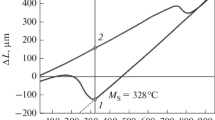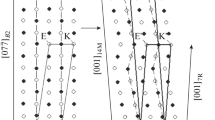Conclusions
-
1.
The cessation of the martensitic transformation in steel and the resumption of the transformation at lower temperatures depend on the change in the mechanical condition of the original phase (austenite) with a simultaneous change in the value of the thermodynamic stimulus of the transformation \3- the difference in free energies \gDFAM. The equation of the martensite curve (9) was derived from comparison of the temperature dependence of \gDFAM T with the resistance of austenite to transformation σ0.2T
The equation obtained indicates that with a constant thermodynamic factor (T0) the values of MS and Mf and the rate of the transformation depend on the original mechanical condition of austenite and its capacity for increasing in strength due to phase strain hardening in the process of the transformation.
-
2.
The condition for complete suppression of the martensitic transformation was shown for any cooling conditions by means of increasing the strength of austenite in macrovolumes and for whiskers.
-
3.
A martensite diagram for iron-carbon alloys was constructed by means of calculations. The calculated curve for TM S is in good agreement with the experimental data. The calculated curve for TM S differs substantially from the experimental data for alloys with over 1% C.
-
4.
The thermodynamic conditions for nucleation of martensite crystals can be utilized only in the case where they are sufficient to overcome the mechanical resistance of the original phase to the transformation. This resistance depends on the original mechanical condition of austenite and its variation with phase strain hardening in the process of the martensitic transformation.
Similar content being viewed by others
Literature cited
M. E. Blanter, Phase Transformations during Heat Treatment of Steel [in Russian], Metallurgizdat, Moscow (1962), Chap. IV.
S. T. Konobeevskii, Zh. Tekh. Fiz., No. 13, 418 (1943).
M. I. Zakharova and N. F. Lashko, Izv. Akad. Nauk SSSR, Ser. Tekh., No. 7, 1015 (1946).
M. E. Blanter and P. V. Novichkov, "Nature of the martensitic transformation", Metal. i Term. Obrabotka Metal., No. 6, 11 (1957).
M. E. Blanter and B. G. Serebrennikova, "The nature of thermal stabilization of austenite," Metal. i Term. Obrabotka Metal., No. 7 (1972).
O. Krisement, E. Houdremont, and F. Wever, Rev. de Metallurgie, No. 4, 401 (1954).
A. P. Gulyaev and V. G. Vorob'ev, Zh. Tekh. Fiz.,21, No. 10, 1117–1163 (1951).
V. G. Vorob'ev, Heat Treatment of Metals [in Russian], Mashgiz, Moscow (1950), p. 125.
A. P. Gulyaev, Heat Treatment of Steel [in Russian], Mashgiz, Moscow (1960), p. 140.
Additional information
All-Union Correspondence Machine Construction Institute. Translated from Metallovedenie i Termicheskaya Obrabotka Metallov, No. 5, pp. 7–11, May, 1975.
Rights and permissions
About this article
Cite this article
Blanter, M.E. The martensitic transformation and the mechanical condition of phases. Met Sci Heat Treat 17, 370–374 (1975). https://doi.org/10.1007/BF00663209
Issue Date:
DOI: https://doi.org/10.1007/BF00663209




